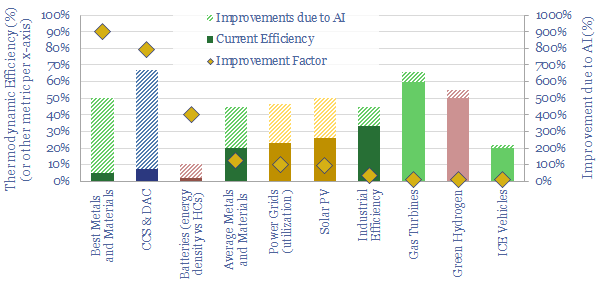AI will be a game-changer for global energy efficiency. It will likely save 10x more energy than it consumes directly, closing thermodynamic gaps where 80-90% of all primary energy is wasted today. Leading corporations will harness AI to lower their costs and accelerate decarbonization. This 19-page note explores opportunities for AI to reshape the energy transition.
How will AI reshape energy transition? What if AI achieved near ‘omniscience’, being able to solve any specific and solvable task that we set it? This 19-page report covers our conclusions for energy, industry and energy transition value chains.
AI will likely ramp up to consume 500 TWH of electricity, directly, by 2030, as covered in our overview of digital energy consumption (pages 2-3). This will create upside for global energy demand in the short-term.
But 80-90% of primary energy is also wasted in today’s global energy system. And the main reason is a lack of knowledge and processing power. A key idea in the note is that AI will help to close these thermodynamic gaps. So where are those thermodynamic gaps greatest, and where can they be narrowed? (pages 2-3).
Rules of engagement. What is and what is not realistic for AI in the energy transition? We set out six rules for AI engines on page 4. Laws of thermodynamics, chemistry, physics are fairly immutable. Some problems are also better suited to AI than others.
How will AI improve industrial efficiency? The energy intensity of global GDP has improved at 1% per year since 1970 (data here, research controversies here). We see AI as sustaining this long-standing trend, maybe mildly accelerating it. This is exciting, but it is not the area that excites us most (pages 5-6).
How will AI improve materials value chains, which consume 40% of all the world’s energy and emit 35% of its CO2? The numbers here are enormous. Thermodynamic efficiency of materials production averages 20% globally (data here). For some processes, AI can unlock 10x gains, equating to 90% reductions in energy use per ton of output (pages 7-8).
How will AI improve the efficiency of heat engines? Next-generation material science can also boost efficiency of gas turbines and jet engines by around 5pp, mainly via improved materials (pages 9-10).
How will AI reshape renewables? We think the efficiency of solar can double again from here, and there are semiconductor technologies in conceptual state space that offer 50% solar efficiency, which is double today’s leading TOPCons (pages 11-12).
How will AI reshape power grids? Electricity rises from 40% of useful energy today to 60% by 2050 (note here). All else equal, this requires transmission infrastructure, distribution infrastructure and power grid capex to rise by 3-5x (note here). But we think AI can likely double the utilization rates of grid infrastructure (pages 13-14).
How will AI reshape CCS and DAC value chains? The thermodynamic efficiency of recently proposed CCS and DAC pathways are around 5-10%. The challenges for 60-90% efficient sorbents and membranes are very large, but so too is the state space of possible sorbents and membranes (pages 15-16).
How will AI reshape lithium-ion batteries, nuclear fusion, green hydrogen value chains or nature-based solutions. We found it harder to de-risk breakthroughs using AI in these areas, as explained on pages 17-18.
What are the best AI opportunities for companies and decision-makers in the energy transition? Our key conclusions are summarized on page 19.
